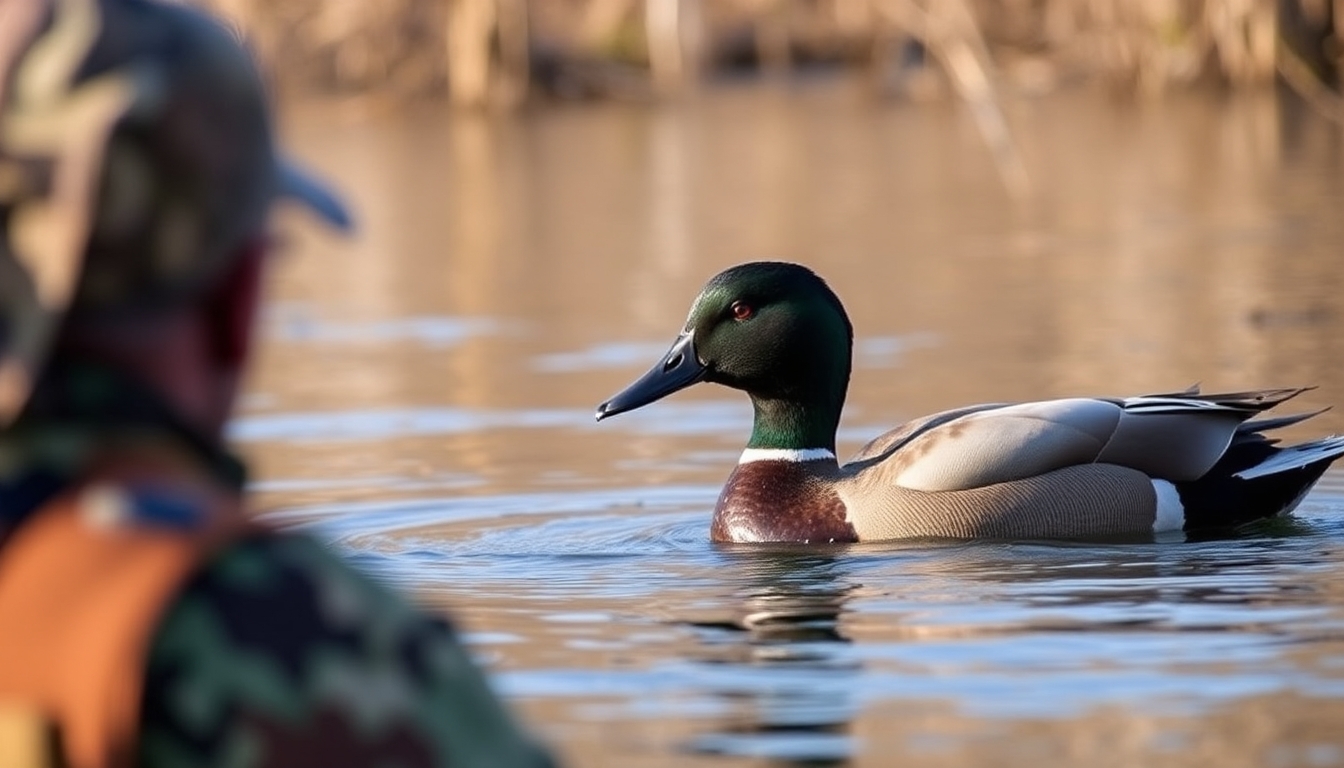Waterfowl hunting, like many outdoor sports, is steeped in tradition, requiring skill, patience, and a deep understanding of the environment. Hunters have relied on decoys, calls, and camouflaged blinds for generations, perfecting their techniques through experience. However, as with many other areas of life, technology is changing the landscape of waterfowl hunting. Future innovations in hunting gear are expected to further enhance hunters’ abilities, making the sport more efficient, ethical, and accessible while still preserving the traditional spirit of the hunt.
From advanced decoys and smart firearms to environmentally friendly gear and AI-driven apps, waterfowl hunting is set to undergo a technological transformation. In this article, we’ll explore the future innovations in waterfowl hunting gear that will redefine how hunters prepare, strategize, and succeed in the field.
1. Smart Decoys: Taking Realism to the Next Level
For decades, decoys have been an essential part of waterfowl hunting, with hunters relying on stationary plastic replicas to mimic the appearance of live ducks. While effective, these decoys have limitations in their ability to fully replicate the dynamic movements of real waterfowl. However, future innovations in decoy technology aim to solve this problem by incorporating smart decoys that take realism to a whole new level.
1.1. Robotic and Programmable Decoys
The future of waterfowl decoys is headed toward automation. Robotic decoys will have programmable movement patterns that can imitate lifelike behaviors such as swimming, diving, and even preening. These advanced decoys will use artificial intelligence (AI) algorithms to adjust their movements based on environmental conditions like wind, water currents, and duck behavior. This dynamic interaction between decoys and the environment will make them far more effective at attracting waterfowl than their static counterparts.
In addition, these decoys may be equipped with sensors to detect nearby birds and adjust their behavior accordingly. For example, a decoy could activate swimming movements when ducks are approaching from a distance or simulate feeding when ducks are circling overhead. This level of realism will make it harder for ducks to distinguish between real and fake birds, greatly increasing the chances of a successful hunt.
1.2. Smart Decoy Control Systems
Future decoy systems may also come with smart controls that allow hunters to manage multiple decoys from a single device, such as a smartphone or remote control. This technology could enable hunters to synchronize the movements of several decoys to create the appearance of a flock behaving naturally on the water. Hunters will be able to program specific patterns and even make adjustments in real-time as they observe waterfowl behavior, giving them more control over the hunting setup than ever before.
2. AI-Powered Hunting Gear: Intelligent Tools for the Modern Hunter
Artificial intelligence is beginning to make its mark in the world of hunting gear, and its potential in waterfowl hunting is particularly promising. AI-driven tools are poised to help hunters make smarter decisions by analyzing data and providing real-time insights that can improve accuracy, timing, and overall success.
2.1. Smart Firearms and Scopes
Smart firearms and scopes are at the forefront of AI innovation in hunting. These advanced tools use AI to assist hunters in making more accurate shots by automatically calculating distance, wind speed, and elevation. Some smart scopes can even adjust reticles based on environmental conditions, ensuring that each shot is perfectly aligned.
In waterfowl hunting, where ducks are often moving targets, this technology will be a game-changer. AI-powered scopes will have the ability to track the movement of birds in real-time and adjust accordingly, helping hunters lead their shots and improve their accuracy. This reduces the number of missed opportunities and ensures cleaner, more ethical kills, minimizing the risk of wounding birds without retrieving them.
Some companies are already developing scopes with heads-up displays (HUDs) that provide additional information, such as wind direction and bullet trajectory, directly within the scope’s viewfinder. This kind of data integration will give hunters a comprehensive understanding of their shooting environment, enhancing precision and confidence in the field.
2.2. AI-Driven Hunting Apps
AI-powered hunting apps are expected to revolutionize the way hunters plan and execute their hunts. Future apps will analyze vast amounts of data, including weather patterns, migration trends, and habitat conditions, to provide hunters with real-time advice on where and when to hunt.
For waterfowl hunters, these apps will be especially valuable in tracking duck migration patterns. By analyzing satellite data, AI will predict the best locations for hunting based on bird populations, movements, and environmental factors. This technology will help hunters save time by directing them to the most productive hunting spots, increasing the chances of success.
In addition, AI-driven apps will be capable of learning from past hunts, analyzing data such as the number of birds harvested, the type of calls used, and the decoy setup. Over time, the app will provide personalized recommendations tailored to the hunter’s style and preferences, helping them refine their techniques and strategies for future hunts.
3. Eco-Friendly Hunting Gear: Sustainability Meets Performance
As awareness of environmental conservation grows, the future of waterfowl hunting gear is likely to focus on sustainability. Hunters are increasingly mindful of their impact on ecosystems, and manufacturers are responding by developing eco-friendly products that reduce waste and pollution without compromising performance.
3.1. Biodegradable Shot and Ammunition
One of the most significant developments in sustainable hunting gear is the creation of biodegradable shot and ammunition. Traditionally, lead shot has been used for waterfowl hunting, but it poses a serious risk to wildlife and the environment. When lead shot is left in wetlands, it can be ingested by birds and other animals, leading to poisoning and death.
To address this issue, future hunting gear will incorporate biodegradable shot made from non-toxic materials, such as steel, tungsten, or bismuth. These alternatives are safer for the environment and wildlife while still providing the necessary performance for effective hunting. Manufacturers are also exploring innovations in shotgun shell casings, with biodegradable or recyclable materials replacing traditional plastic to minimize environmental waste.
3.2. Sustainable Hunting Clothing and Gear
Another area where sustainability is gaining traction is in hunting clothing and gear. Future innovations will focus on using eco-friendly fabrics and materials without sacrificing durability or functionality. For example, hunting apparel brands may incorporate recycled or sustainably sourced materials into their products, reducing the carbon footprint of manufacturing.
Some companies are already experimenting with materials like recycled polyester and organic cotton for hunting clothing. In addition, water-resistant coatings on jackets, pants, and waders may be made from eco-friendly compounds that are less harmful to the environment than traditional chemicals.
4. Advanced Camouflage Technology: Perfecting Concealment
Effective camouflage has always been a crucial element of waterfowl hunting, allowing hunters to blend into their surroundings and remain undetected by ducks. Future innovations in camouflage technology will push the boundaries of concealment, incorporating advanced materials and designs that adapt to changing environments.
4.1. Adaptive Camouflage Materials
One of the most exciting developments in camouflage technology is the emergence of adaptive materials that can change color or pattern based on the environment. These materials, inspired by the natural world (such as chameleons and cephalopods), can adjust their appearance to match the surrounding landscape, providing hunters with superior concealment regardless of the terrain or weather conditions.
For waterfowl hunters, who often face a wide range of environmental settings—such as marshes, open water, and dense reeds—adaptive camouflage would eliminate the need for multiple outfits or gear changes. Whether hunting in bright sunlight, overcast skies, or in snow-covered areas, the adaptive material would ensure the hunter remains perfectly camouflaged.
4.2. Advanced 3D Printing for Custom Camo
3D printing technology is poised to revolutionize the way hunting camouflage is designed and manufactured. In the near future, hunters may have the option to create custom camo patterns tailored to the specific environments in which they hunt. Using 3D printing technology, manufacturers will be able to replicate highly detailed patterns based on the local terrain, vegetation, and color schemes.
In addition, 3D printing can create gear with complex textures that mimic the physical appearance of natural objects, such as bark, grass, or water ripples. This level of customization will allow hunters to blend in more effectively, enhancing their concealment and increasing the chances of a successful hunt.
5. Wearable Technology: Enhancing Safety and Efficiency
Wearable technology is another area of innovation that will have a significant impact on waterfowl hunting. Devices like smart watches, fitness trackers, and GPS-enabled gear are already popular in other outdoor sports, and their use in hunting is only expected to grow.
5.1. GPS Tracking for Hunters and Dogs
Future wearable technology will include advanced GPS tracking systems that allow hunters to keep track of both themselves and their hunting dogs. This is particularly valuable in large hunting areas or difficult terrains, where it’s easy to lose track of location. GPS tracking will ensure that hunters know exactly where their dogs are at all times, reducing the risk of them getting lost or injured.
These systems will also improve safety by allowing hunters to monitor their own movements and share their location with other members of their hunting party. In case of an emergency, wearable devices with SOS functions can send distress signals to nearby hunters or emergency services, ensuring a quick response.
5.2. Health Monitoring Devices
Health and safety are important considerations during long hunting trips, especially in cold or wet conditions. Wearable health monitoring devices will become increasingly sophisticated, offering hunters real-time insights into their physical condition. These devices can track heart rate, body temperature, hydration levels, and more, helping hunters avoid exhaustion or hypothermia during extended hunts in challenging environments.
In addition, smart clothing with built-in sensors could alert hunters to potential health risks by monitoring vital signs and providing

